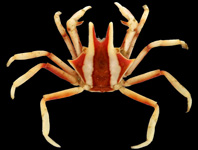Abstract
A newly discovered, diminutive, cave-dwelling, lowland species of the colubrid snake genus Lycodon Boie is described from a limestone cave along the Thai-Malaysian border in the state of Perlis, northwestern Peninsular Malaysia. Lycodon cavernicolus sp. nov. is most closely related to L. butleri Boulenger, an endemic, upland, forest-dwelling species from Peninsular Malaysia of the fasciatus group but is separated from L. butleri and all other species of the L. fasciatus group and the closely related L. ruhstrati group by having the combination of 245 (male) and 232 (female) ventral scales; 113 (male) and 92 (female) paired, subcaudal scales; a single precloacal plate; nine or 10 supralabials; 10 or 11 infralabials; a maximum total length of 508 mm (female); a relative tail length of 0.25–0.27; an immaculate venter in juveniles and dark-brown, posterior, ventral scale margins in adults; and dorsal and caudal bands in juveniles white. The discovery of L. cavernicolus sp. nov. adds to a rapidly growing list of newly discovered reptiles from karst regions and limestone forests of Peninsular Malaysia, underscoring the fact that these areas should be studied before they are quarried as they harbor a significant portion of the Peninsular Malaysia’s herpetological diversity.

